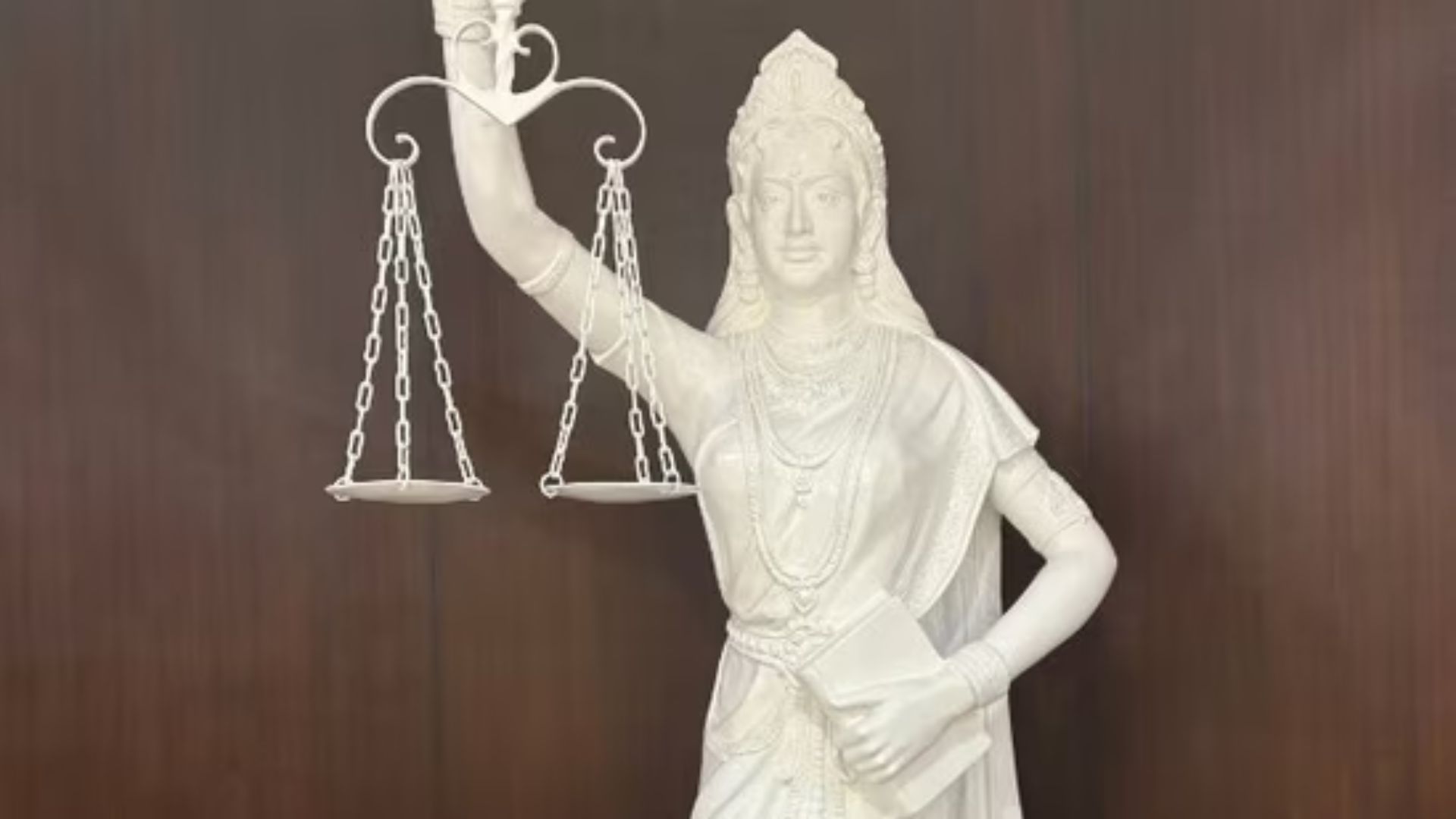In a symbolic shift, a new statue of the Lady of Justice has been unveiled at the Supreme Court, aturing significant changes to its traditional form. The blindfold, which typically symbolises impartiality, has been removed, and the Indian Constitution has replaced the sword in the statue’s left hand. Additionally, the Lady of Justice now dons a saree, replacing the traditional Western robe, reflecting a shift toward Indian cultural identity.
The newly unveiled Lady Justice statue at India›s Supreme Court symbolizes a shift from colonial traditions to modern values, emphasizing constitutional justice, awareness, and inclusivity. Traditionally depicted with a blindfold and a sword, the new statue now features ‘Lady Justice’ with open eyes and the Constitution of India in place of the sword, reflecting the judiciary’s commitment to constitutional values and justice that “sees everyone equally”.
These changes were initiated under Chief Justice DY Chandrachud’s leadership, aiming to modernize the judiciary and move away from colonial legacies. The open-eyed Lady Justice statue at the Supreme Court of India signifies a transformative view of justice’s role in society, reflecting modern values and principles.
Changing meaning
The imagery of Lady Justice can be traced back to Greek and Roman mythology. Themis, one of the 12 Titans born to Gaea and Uranus according to works of the Greek poet Hesiod who lived circa 700 BCE, is known as the goddess of justice, wisdom, and good counsel — and is often depicted as a woman holding scales in one hand and a sword in the other. The first Roman emperor Augustus (27 BCE-14 CE) introduced the worship of Justice in the form of a goddess known as Justitia (or Iustitia). Justitia, like Themis, did not wear a blindfold.
Lady Justice in India
Along with the common law legal system that continues to serve as the basis for how India’s judiciary functions, the British Raj also introduced the iconography of Lady Justice. This image still survives in courthouses around the country. At the Calcutta High Court — first constructed in 1872 — images of Lady Justice were carved into the pillars supporting the building. The depictions show Lady Justice blindfolded in some cases, and with her eyes open in others. The Bombay High Court too, features a statue of Lady Justice at the top of one of its buildings, once again without a blindfold. The new statue at the Supreme Court is very similar to another piece of art featured on the premises. A mural close to the judges’ entrance shows Mahatma Gandhi and Lady Justice on either side of a chakra; Lady Justice in this depiction is wearing a saree, and holding scales and a book instead of a sword.
From Tradition to Modern
Traditionally, the blindfold suggested equality before the law, meaning that the dispensation of justice should not be influenced by the status, wealth, or power of the parties. The sword historically symbolised authority and the capacity to punish injustice. In a departure from colonial influences, like the replacement of the colonial-era penal code with the Bharatiya Nyaya Sanhita, the new Lady Justice signifies that the law in the country sees everyone equally as mandated under the Constitution. The might of the Constitution, not of the sword, prevails in the justice delivery process.
The removal of the blindfold from ‘Lady Justice’ is more than a visual change—it symbolises a shift in how the judiciary views justice in Modern India. The blindfold, long associated with impartiality and equality before the law, has been replaced with open eyes. Open eyes symbolize knowledge about the complexity and differentiation within society. The image would then contrast for it is, in a way, an icon of detached impartiality. The statue holds the Constitution in her hand rather than a sword, much as to indicate that justice is deep-rooted into constitutional values rather than punishment. Shifting from such practices showed a commitment to uphold rights and fairness in the eye of the Constitution against symbols of colonial authority and violence.
The design has a more inclusive aspect toward justice, meaning that it is supposed to take aboard different viewpoints and experiences instead of ascribing everyone as same in the eyes of the law. This is at par with what Chief Justice DY Chandrachud holds forth and his claim that “the law is not blind; it sees everyone equally”, legal identity evolving into one that grants equality and fairness.The renovation is a purposeful act that seeks to move away from manifestations of the colonial era. Adopting an understanding of justice that would strictly be Indian, the statue represented an allegiance to the institutionalization of a modern legal system that would align instead with societal values as it stands today.
Where the sword was displaced by the scales of justice, this goes to prove that its post-replacement alternative represents a continued dedication to balance and fairness in judicial decisions. This helps underscore that courts will continue weighing evidence impartially, hearing all parties’ voices before making any decision before it.
Breaking free from colonial legacy
The redesign of ‘Lady Justice’ aligns with a broader effort by the Indian judiciary to shed its colonial past. Recent legal reforms, such as the introduction of the Bharatiya Nyaya Sanhita (BNS) to replace the Indian Penal Code (IPC), underscore this movement. CJI Chandrachud has been vocal about the need to break away from British-era symbols and laws, emphasising that the judiciary’s role is not punitive but protective of constitutional rights. It is believed among the judiciary that India should move forward from the British legacy, and that the law is never blind; it sees everyone equally. This philosophy is embodied in the redesigned ‘Lady Justice’, which now represents the Constitution as the ultimate source of justice.
Message for the Young Generation
For children and young people, this reinterpretation of Lady Justice holds profound significance. The open eyes of Lady Justice symbolize understanding and empathy, qualities that are essential in any system of law. By embracing the Constitution instead of a sword, the statue conveys that justice should be constructive rather than punitive. It emphasizes the importance of law as a framework for protection and rights, especially for vulnerable groups such as children. The introduction of this statue provides an opportunity for educational initiatives surrounding justice and law. Schools and communities can engage in discussions about the Constitution and its role in protecting rights, particularly those of children. This aligns with a broader movement to instill values of justice, responsibility, and empathy in the younger generation. Chief Justice DY Chandrachud’s initiative reflects a progressive vision for the Indian judiciary—one that prioritizes justice in its most compassionate form. By showcasing Lady Justice as a guardian of the Constitution, the statue serves as a reminder that the law is a living entity, designed to protect and uplift society, rather than merely punish wrongdoings.
Way Ahead
The new Lady Justice statue at the Supreme Court of India is more than just a piece of art; it is a powerful statement about the nature of justice in the 21st century. For children, it represents a future where the law is not just a set of rules but a nurturing force that champions their rights and well-being. As we look forward, this statue stands as a beacon of hope, reminding us all that justice should be seen, understood, and embraced with open eyes.
Dr.S.Krishnan is an Associate Professor in Seedling School of Law and Governance, Jaipur National University, Jaipur.
Ms. Gauri Dwivedi is a Final Year Student of BALLB, Seedling School of Law and Governance, Jaipur National University, Jaipur.










